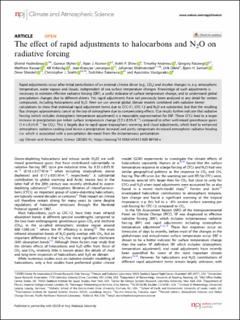| dc.contributor.author | Hodnebrog, Øivind | |
| dc.contributor.author | Myhre, Gunnar | |
| dc.contributor.author | Kramer, Ryan J. | |
| dc.contributor.author | Shine, Keith P. | |
| dc.contributor.author | Andrews, Timothy | |
| dc.contributor.author | Faluvegi, Greg | |
| dc.contributor.author | Kasoar, Matthew | |
| dc.contributor.author | Kirkevåg, Alf | |
| dc.contributor.author | Lamarque, Jean-Francois | |
| dc.contributor.author | Mülmenstädt, Johannes | |
| dc.contributor.author | Oliviè, Dirk Jan Leo | |
| dc.contributor.author | Samset, Bjørn Hallvard | |
| dc.contributor.author | Shindell, Drew | |
| dc.contributor.author | Smith, Christopher J. | |
| dc.contributor.author | Takemura, Toshihiko | |
| dc.contributor.author | Voulgarakis, Apostolos | |
| dc.date.accessioned | 2021-08-11T11:03:46Z | |
| dc.date.available | 2021-08-11T11:03:46Z | |
| dc.date.created | 2020-11-19T19:42:02Z | |
| dc.date.issued | 2020 | |
| dc.identifier.citation | npj Climate and Atmospheric Science. 2020, 3:43 1-7. | en_US |
| dc.identifier.issn | 2397-3722 | |
| dc.identifier.uri | https://hdl.handle.net/11250/2767360 | |
| dc.description.abstract | Rapid adjustments occur after initial perturbation of an external climate driver (e.g., CO2) and involve changes in, e.g. atmospheric temperature, water vapour and clouds, independent of sea surface temperature changes. Knowledge of such adjustments is necessary to estimate effective radiative forcing (ERF), a useful indicator of surface temperature change, and to understand global precipitation changes due to different drivers. Yet, rapid adjustments have not previously been analysed in any detail for certain compounds, including halocarbons and N2O. Here we use several global climate models combined with radiative kernel calculations to show that individual rapid adjustment terms due to CFC-11, CFC-12 and N2O are substantial, but that the resulting flux changes approximately cancel at the top-of-atmosphere due to compensating effects. Our results further indicate that radiative forcing (which includes stratospheric temperature adjustment) is a reasonable approximation for ERF. These CFCs lead to a larger increase in precipitation per kelvin surface temperature change (2.2 ± 0.3% K−1) compared to other well-mixed greenhouse gases (1.4 ± 0.3% K−1 for CO2). This is largely due to rapid upper tropospheric warming and cloud adjustments, which lead to enhanced atmospheric radiative cooling (and hence a precipitation increase) and partly compensate increased atmospheric radiative heating (i.e. which is associated with a precipitation decrease) from the instantaneous perturbation. | en_US |
| dc.language.iso | eng | en_US |
| dc.publisher | Springer Nature Ltd | en_US |
| dc.rights | Navngivelse 4.0 Internasjonal | * |
| dc.rights.uri | http://creativecommons.org/licenses/by/4.0/deed.no | * |
| dc.title | The effect of rapid adjustments to halocarbons and N2O on radiative forcing | en_US |
| dc.type | Journal article | en_US |
| dc.type | Peer reviewed | en_US |
| dc.description.version | publishedVersion | en_US |
| dc.source.pagenumber | 1-7 | en_US |
| dc.source.volume | 3:43 | en_US |
| dc.source.journal | npj Climate and Atmospheric Science | en_US |
| dc.identifier.doi | 10.1038/s41612-020-00150-x | |
| dc.identifier.cristin | 1850091 | |
| dc.relation.project | Norges forskningsråd: 229771 | en_US |
| dc.relation.project | Norges forskningsråd: 270061 | en_US |
| dc.relation.project | Norges forskningsråd: 295046 | en_US |
| cristin.ispublished | true | |
| cristin.fulltext | original | |
| cristin.qualitycode | 1 | |

